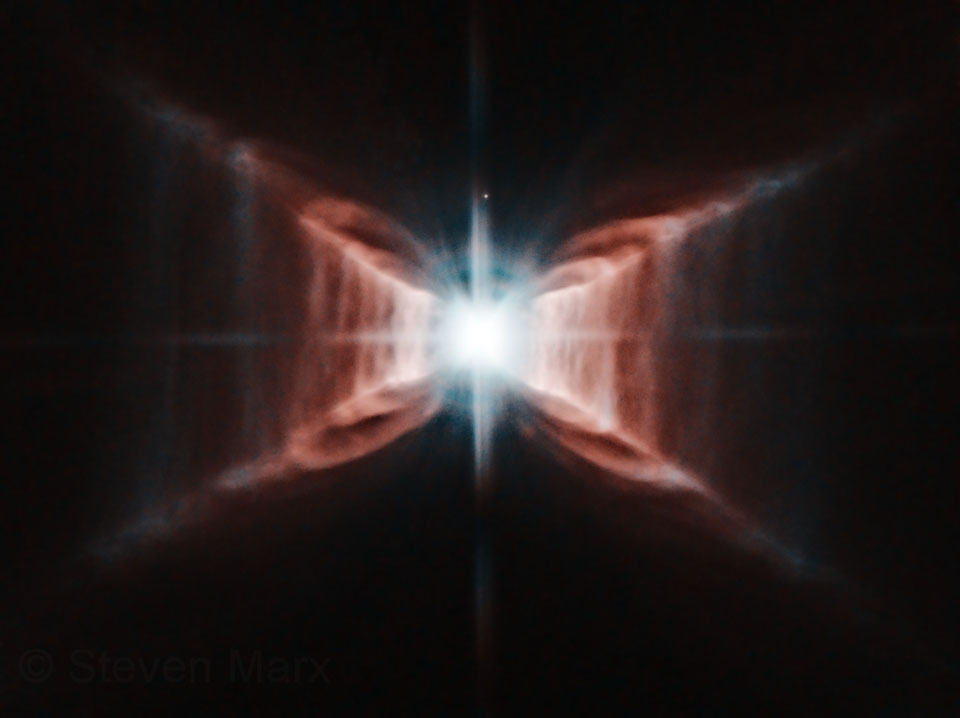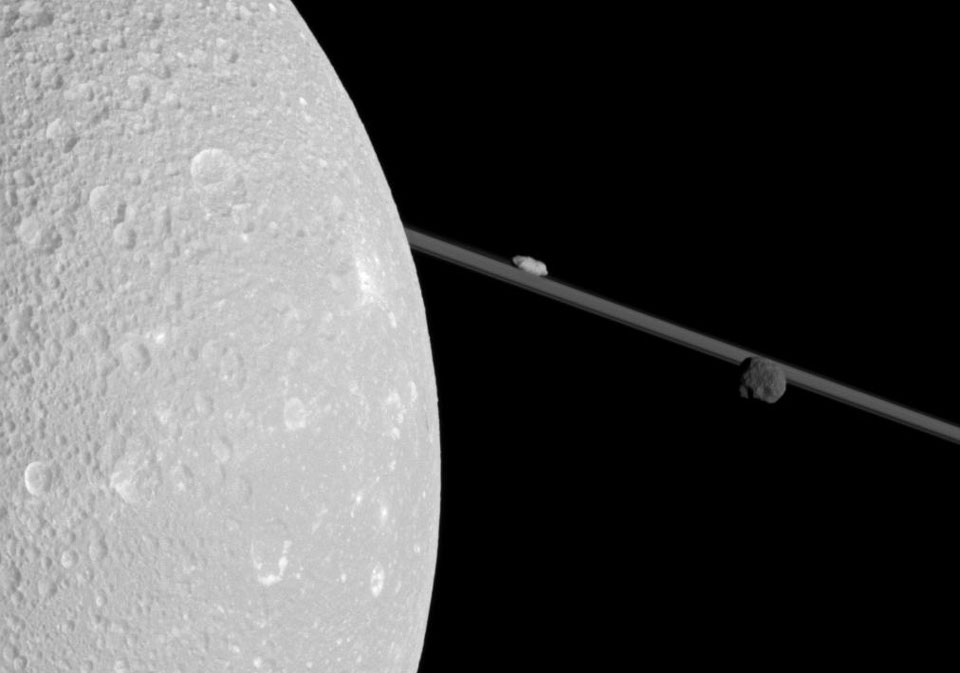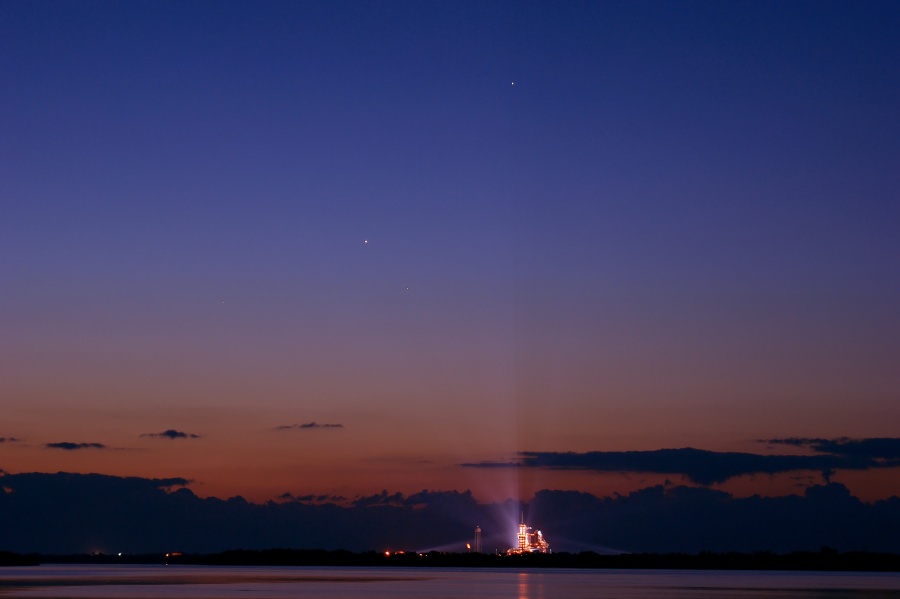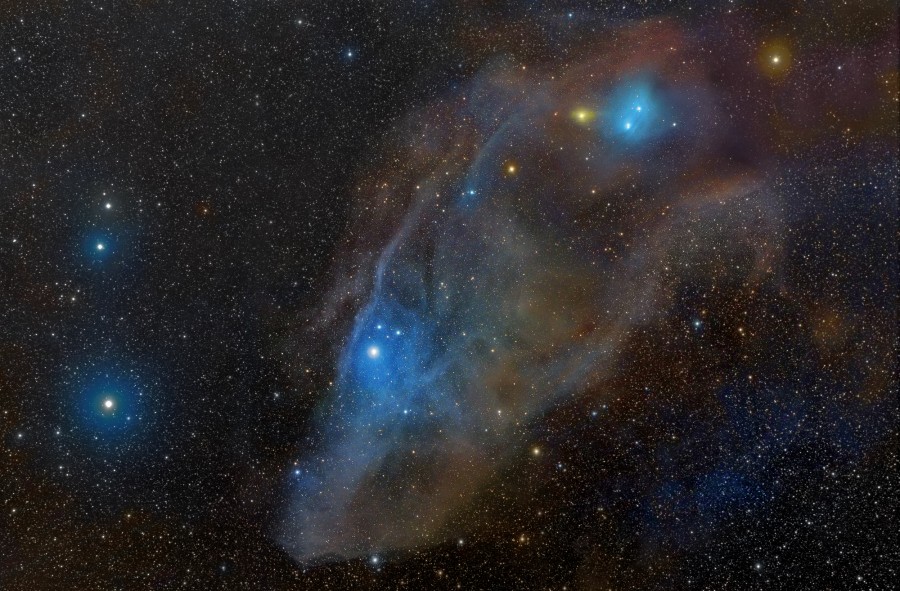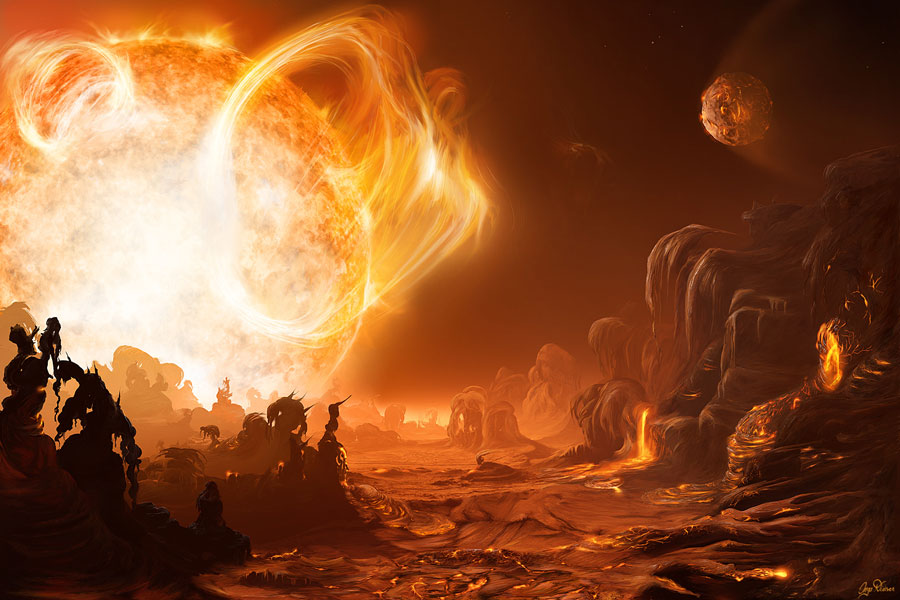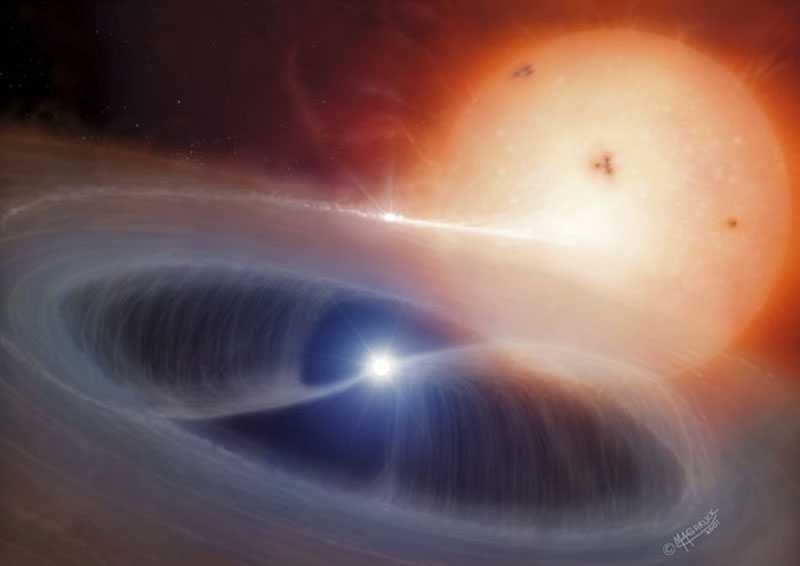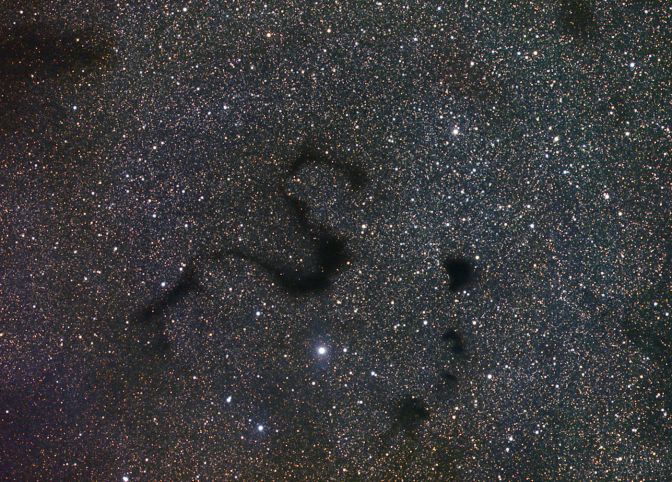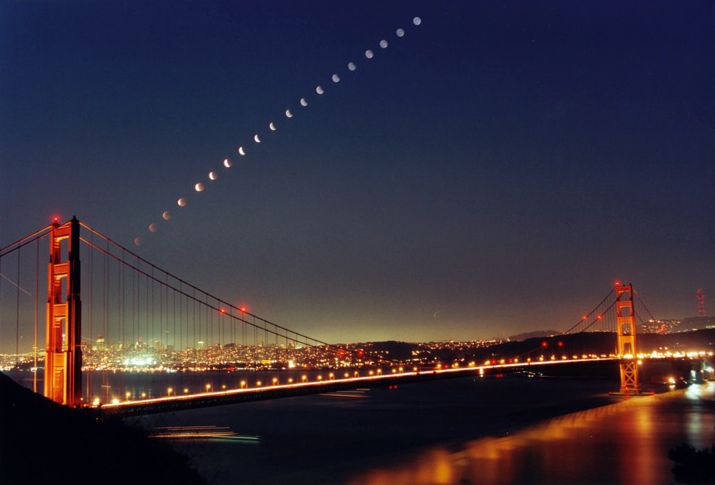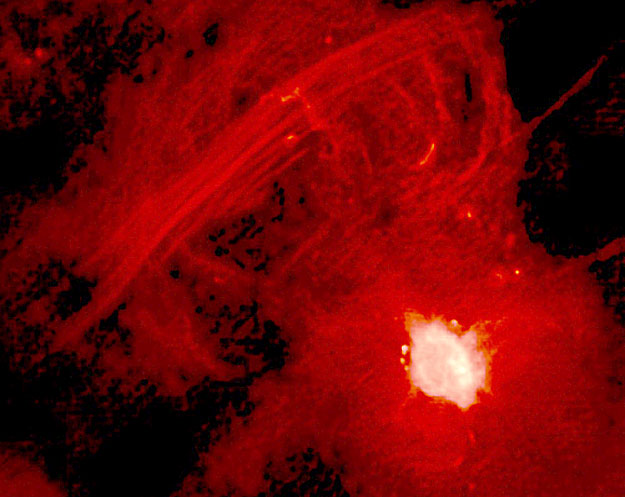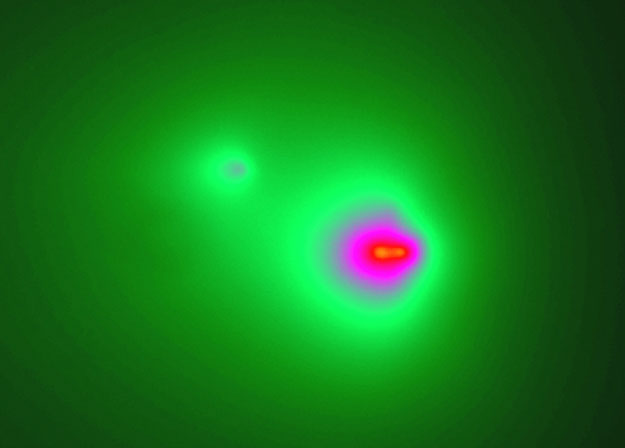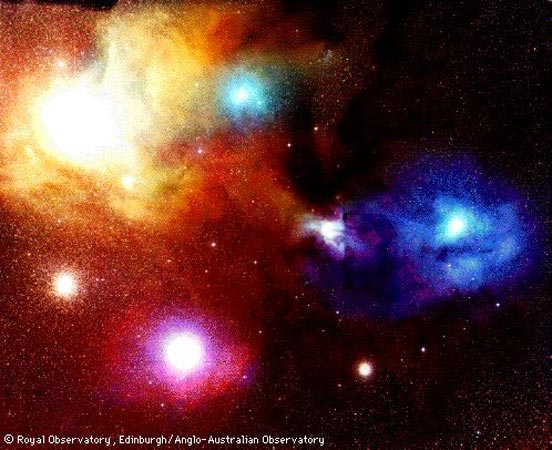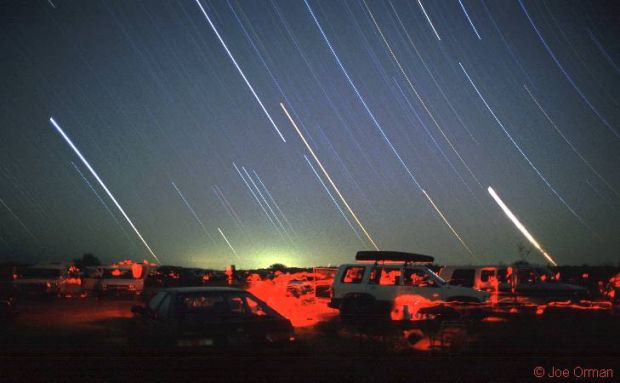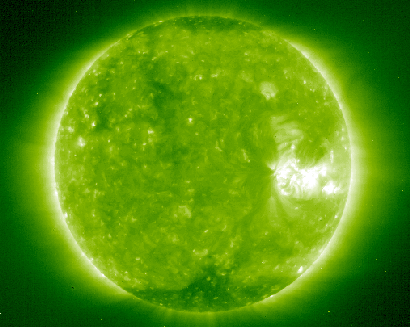| << Previous | Index | Next >> |
2015
2014
Click to play embedded YouTube video.
Video Credit: Basehunters (BasehuntersChasing) Music: Empire (Shakira)
2013 How was the unusual Red Rectangle nebula created? At the nebula's center is an aging binary star system that surely powers the nebula but does not, as yet, explain its colors. The unusual shape of the Red Rectangle is likely due to a thick dust torus which pinches the otherwise spherical outflow into tip-touching cone shapes. Because we view the torus edge-on, the boundary edges of the cone shapes seem to form an X. The distinct rungs suggest the outflow occurs in fits and starts. The unusual colors of the nebula are less well understood, however, and speculation holds that they are partly provided by hydrocarbon molecules that may actually be building blocks for organic life. The Red Rectangle nebula lies about 2,300 light years away towards the constellation of the Unicorn (Monoceros). The nebula is shown above in great detail as recently reprocessed image from Hubble Space Telescope. In a few million years, as one of the central stars becomes further depleted of nuclear fuel, the Red Rectangle nebula will likely bloom into a planetary nebula.
2012 What's that past Dione? When making its closest pass yet of Saturn's moon Dione late last year, the robotic Cassini spacecraft snapped this far-ranging picture featuring Dione, Saturn's rings, and the two small moons Epimetheus and Prometheus. The above image captures part of the heavily cratered snow-white surface of the 1,100 kilometer wide Dione, the thinness of Saturn's rings, and the comparative darkness of the smaller moon Epimetheus. The image was taken when Cassini was only about 100,000 kilometers from the large icy moon. Future events in Cassini's continuing exploration of Saturn and its moons include tomorrow's flyby of Titan and imaging the distant Earth passing behind Saturn in June.
2011 When dawn broke over Kennedy Space Center on Monday, May 16, the space shuttle orbiter Endeavour still stood on pad 39A. Its final launch, on mission STS-134 to the International Space Station, was only hours away. Shining through the early morning twilight four planets were also poised above the eastern horizon, a moving scene captured here from across the Banana River at the center's Saturn V VIP viewing site. Scattered by planet Earth's dense atmosphere, floodlight beams play over the launch pad, glancing skyward toward the celestial beacons. Jupiter is highest, near the top of the frame, but even the solar sytem's ruling gas giant is outshone by brilliant Venus near picture center. Innermost planet Mercury is below Venus, to the right. Below and left, Mars almost fades into the twilight glow. The four planets continue to hug the eastern horizon at dawn throughout the month, while Endeavour is now scheduled to make its final approach to planet Earth on June 1.
2010 Last weekend, the Moon and Venus formed a beautiful close pair in the west after sunset, a scene enjoyed by skygazers all over the world. In this lovely view of the conjunction from Sweden, a calm lake Vallentuna lies in the foreground with sunset colors still fading behind the treeline on the far shore. The young Moon's sunlit crescent is bright, but its entire outline can be seen by Earthshine, light reflected from planet Earth itself. For well-placed skygazers, on Sunday, May 16 the Moon actually occulted (passed in front of) brilliant Venus. For many, the occultation was visible during daylight hours.
2009 This complex of beautiful, dusty reflection nebulae lies in the constellation Scorpius along the plane of our Milky Way Galaxy. Its overall outline suggests a horsehead in profile, though it covers a much larger region than the better known Horsehead Nebula of Orion. The star near the eye of the horse and the center of the 5 degree wide field, is embedded in blue reflection nebula IC 4592 over 400 light-years away. At that distance, the view spans nearly 40 light-years. The horse's gaze seems fixed on Beta Scorpii, also named Graffias, the bright star at the lower left. Toward the top right, near the horse's ear, is another striking bluish reflection nebula, IC 4601. The characteristic blue hue of reflection nebulae is caused by the tendency of interstellar dust to more strongly scatter blue starlight.
2008 On planet Gliese 876d, sunrises might be dangerous. Although nobody really knows what conditions are like on this close-in planet orbiting variable red dwarf star Gliese 876, the above artistic illustration gives one impression. With an orbit well inside Mercury and a mass several times that of Earth, Gliese 876d might rotate so slowly that dramatic differences exist between night and day. Gliese 876d is imagined above showing significant volcanism, possibly caused by gravitational tides flexing and internally heating the planet, and possibly more volatile during the day. The rising red dwarf star shows expected stellar magnetic activity which includes dramatic and violent prominences. In the sky above, a hypothetical moon has its thin atmosphere blown away by the red dwarf's stellar wind. Gliese 876d excites the imagination partly because it is one of the few extrasolar planets known to be close to the habitable zone of its parent star.
2007 The dust is so thick in the center of NGC 1333 that you can hardly see the stars forming. Conversely, the very dust clouds that hide the stars also reflects their optical light, giving NGC 1333's predominantly blue glow the general designation of a reflection nebula. A highly detailed image of the nebula, shown above, was taken recently by the Mayall 4-meter telescope on Kitt Peak in Arizona, USA and released to honor astronomer Stephen Strom on his retirement. Visible near the image top are vast blue regions of dust predominantly reflecting the light from bright massive stars. Visible in the thick central dust are not only newly formed stars but red jets and red-glowing gas energized by the light and winds from recently formed young stars. The NGC 1333 nebula contains hundreds of newly formed stars that are less than one million years old. Reflection nebula NGC 1333 lies about 1,000 light years away toward the constellation of Perseus.
2006 How can two stars create such a strange and intricate structure? Most stars are members of multiple-star systems. Some stars are members of close binary systems where material from one star swirls around the other in an accretion disk. Only a handful of stars, however, are members of an intermediate polar, a system featuring a white dwarf star with a magnetic field that significantly pushes out the inner accretion disk, only allowing material to fall down its magnetic poles. Shown above is an artist's depiction of an intermediate polar system, also known as a DQ Hercules system. The foreground white dwarf is so close to the normal star that it strips away its outer atmosphere. As the white dwarf spins, the columns of infalling gas rotate with it. The name intermediate polar derives from observations of emitted light polarized at a level intermediate to non-disk binary systems known as polars. Intermediate polars are a type of cataclysmic variable star system.
2005 Dark nebulae snake across a gorgeous expanse of stars in this wide-field view toward the pronounceable constellation Ophiuchus and the center of our Milky Way Galaxy. In fact, the central S-shape seen here is well known as the Snake Nebula. It is also listed as Barnard 72 (B72), one of 182 dark markings of the sky cataloged in the early 20th century by astronomer E. E. Barnard. Unlike bright emission nebulae and star clusters, Barnard's nebulae are interstellar dark clouds of obscuring gas and dust. Their shapes are visible in cosmic silhouette only because they lie in the foreground along the line of sight to rich star fields and glowing stellar nurseries near the plane of our Galaxy. Many of Barnard's dark nebulae are themselves likely sites of future star formation. Barnard 72 is a few light years across and about 650 light years away.
2004 Venus is currently falling out of the western evening sky. Second planet from the Sun and third brightest celestial object after the Sun and Moon, Venus has been appreciated by casual sky gazers as a brilliant beacon above the horizon after sunset. But telescopic images have also revealed its dramatic phases. In fact, this thoughtful composite of telescopic views nicely illustrates the progression of phases and increase in apparent size undergone by Venus over the past few weeks. Gliding along its interior orbit, Venus has been catching up with planet Earth, growing larger as it draws near. At the same time, just as the Moon goes through phases, Venus' visible sunlit hemisphere has presented an increasingly slender, crescent shape. Now sharing the sky with a crescent Moon, on June 8th Venus will actually cross the face of the Sun, the first such transit since 1882.
2003 When the Moon rose over San Francisco's Golden Gate Bridge on May 15, both bridge and Moon were in already in Earth's shadow. Of course, the bridge is in the Earth's shadow nightly, while the Moon only has that opportunity about twice a year, during a lunar eclipse. And even though in western North America the total phase of the lunar eclipse began before moonrise, many in areas with clear skies came out to enjoy the spectacle. For this eclipse, skygazers reported a darker than normal, copper-colored Moon during totality. The dramatic color is evident in this multiple exposure of the reddened Moon rising, taken by astrophotographer Evad Damast. Damast viewed the eclipse from the Marin Headlands north and west of the famous bridge, looking back toward the bay and the city lights.
2002 What causes this unusual structure near the center of our Galaxy? The long parallel rays slanting across the top of the above radio image are known collectively as the Galactic Center Radio Arc and jut straight out from the Galactic plane. The Radio Arc is connected to the Galactic center by strange curving filaments known as the Arches. The bright radio structure at the bottom right likely surrounds a black hole at the Galactic center and is known as Sagittarius A*. One origin hypothesis holds that the Radio Arc and the Arches have their geometry because they contain hot plasma flowing along lines of constant magnetic field. Recent images from the Chandra X-ray Observatory appear to show this plasma colliding with a nearby cloud of cold gas.
2001 Last year, a different comet LINEAR (C/1999 S4) broke up. This year, a comet first imaged by the Lincoln Near Asteroid Research (LINEAR) telescope in New Mexico on 2001 January 3, is also breaking up. This new Comet LINEAR (C/2001 A2) unexpectedly brightened to the edge of naked-eye visiblilty a few weeks ago when its nucleus broke in two. Observations taken just last week now indicate that one of the two remaining nuclear fragments has again fragmented. The first piece to break off is visible on the upper left of the above false-color image by a Very Large Telescope, while additional fragmentation is inferred from the brightness and elongation of the spot on the lower right. When a comet nucleus splits, new surfaces are exposed and previously trapped ice and gas are released that evaporate and brighten in the energetic sunlight. Comet LINEAR may remain visible with little or no optical aid into early June. In contrast, at least two other much dimmer Comet LINEARs discovered recently appear stable.
2000 Why is the sky near Antares and Rho Ophiuchi so colorful? The colors result from a mixture of objects and processes. Fine dust illuminated from the front by starlight produces blue reflection nebulae. Gaseous clouds whose atoms are excited by ultraviolet starlight produce reddish emission nebulae. Backlit dust clouds block starlight and so appear dark. Antares, a red supergiant and one of the brighter stars in the night sky, lights up the yellow-red clouds on the upper left. Rho Ophiuchi lies at the center of the blue nebula on the right. The distant globular cluster M4 is visible just below Antares, and to the left of the red cloud engulfing Sigma Scorpii. These star clouds are even more colorful than humans can see, emitting light across the electromagnetic spectrum.
1999 Stargazing is fun! If you'd like to try it, this weekend may be your chance as many astronomy clubs and organizations will be hosting public celebrations of Astronomy Day on Saturday, May 22nd. In recent years, open house nights at observatories, astronomy club gatherings, and star parties have become increasingly popular. They offer great opportunities for beginners to view the sky through a variety of telescopes and veterans to swap stories and ideas. This time exposure of star trails was made last month at the Sentinel, Arizona "Stargaze" star party. On the right, a brilliant trail tracks the setting evening star, Venus. Stars in Orion are near the center and bright Sirius produced the prominent trail at the left. City lights from nearby Yuma glow on the horizon while party-goers' red filtered flashlights create the eerie foreground effect. The red flashlights are courteously used to provide a safe level of illumination but still preserve night vision for enjoyable stargazing.
1998 Discovered this month with an orbiting solar observatory, bright Comet SOHO has now emerged from the Sun's glare. This telephoto picture of the new naked-eye comet was taken by astrophotographer Michael Horn after sunset in the western twilight above Lake Samsonvale, Brisbane, Australia on May 18. The comet is seen in the constellation Orion. Its long lovely tail stretches nearly 5 degrees to the bright star Bellatrix, near the top of the image. For Southern Hemisphere comet watchers, views of Comet SOHO (1998J1) will improve as this month draws to a close and the comet climbs to the south and east on its journey outward bound. In February 1999, NASA plans to launch the Stardust mission to fly close to a comet and return samples of dust from a comet's tail.
1997 New evidence bolsters once controversial claims that Gamma-Ray Bursts (GRBs) are the most powerful explosions ever found by humanity. Two weeks ago, an average GRB became instantly historic when prompt, coincident X-ray and optical emissions were identified. The glow in visible light was particularly interesting because it showed color gaps indicative of absorbing gas at the very distant redshift of 0.8. If GRBs do occur this far into our universe, then radio emission was predicted to peak about a week after the optical emission. Now, late reports do indicate that radio emission has been detected and does peak a week later than the optical. This adds credibility to the claim that these bursts of gamma-radiation indeed occur far from our familiar home Galaxy. Shown above are two photos highlighting the changing optical emission from GRB970508 when it was increasing in brightness. Now light from this enigmatic explosion is fading.
1996 The ultraviolet light emitted by eleven times ionized iron at temperatures over 2 million degrees Farenheit was used to record the above picture of the Sun on May 16. The image was made by the EIT camera onboard the SOHO spacecraft, a space observatory which can continuously observe the Sun. Eleven times ionized iron is atomic iron with eleven of its electrons stripped away. Here the electrons are stripped by the frantic collisions with other atoms and electrons which occur at the extreme temperatures in the Solar Corona. Since electrons are negatively charged, the resulting ionized iron atom is highly positively charged. Astronomer's "shorthand" for eleven times ionized iron is written "Fe XII", the chemical symbol for iron followed by a Roman numeral 12 (Fe I is neutral iron).
| << Previous | Index | Next >> |

